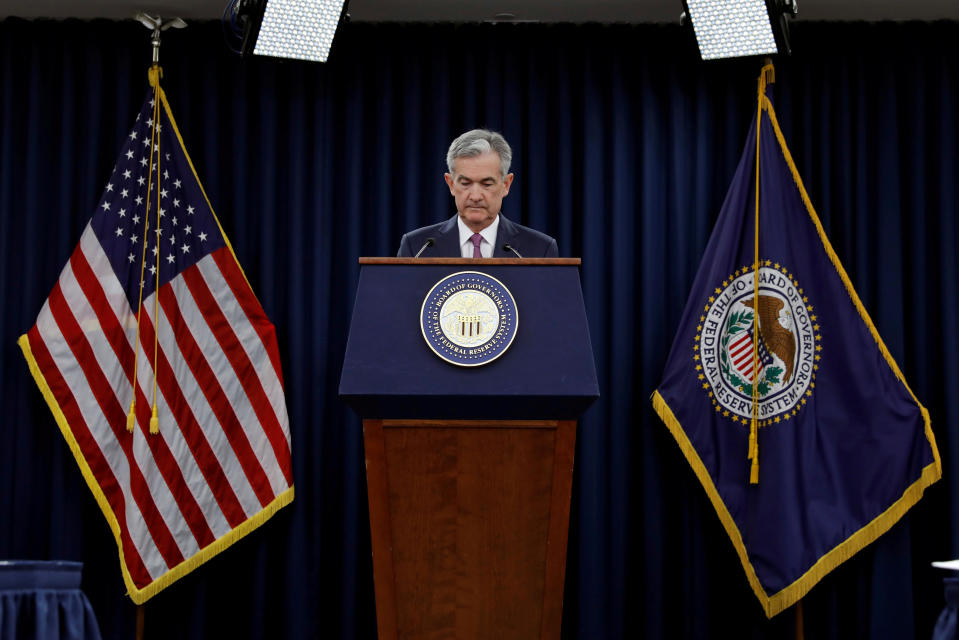It's the end of an era for Fed communications
On Thursday, the Federal Reserve kept interest rates unchanged in a range of 2%-2.25%.
Following this policy announcement, Fed chair Jay Powell did not meet with reporters to answer questions on the thinking behind the Fed’s decision. Ahead of Thursday’s meeting, economists at Bank of America Merrill Lynch previewed the November FOMC decision by writing, “see you in December.” Markets, ultimately, were little-changed. There was little for investors to glean from Thursday’s news.
But this era — where some Fed meetings come and go with little fanfare because of limited communication from the central bank — comes to an end on Thursday.
Starting in January 2019, Fed chair Jay Powell will hold a press conference following each of the Fed’s eight policy decisions. Currently, the Fed holds press conferences quarterly when the central bank’s summary of economic projections is updated; the next Fed press conference will be held in December.
“As Chairman, I hope to foster a public conversation about what the Fed is doing to support a strong and resilient economy,” Powell said in June. “And one practical step in doing so is to have a press conference like this after every one of our scheduled FOMC meetings.”
Powell added that these press conferences, “will give us more opportunities to explain our actions and to answer your questions,” adding that, “this change is only about improving communications.”
And while Powell emphasized markets should not take any signal about the pace of future rate hikes as a result of more frequent Fed communications, this shift in Powell’s communication schedule will also keep investors more alert ahead of each Fed decision.

In 2015, the Fed approached the beginning of its post-crisis rate hiking cycle, then-Fed chair Janet Yellen emphasized to investors that each meeting was “live,” meaning that interest rates could be raised at any meeting.
Markets, however, have for years been pricing in interest rate hikes at only one of the Fed’s quarterly meetings that are accompanied by press conferences with the Fed chair. Yellen’s argument that all meetings were realistic opportunities for the Fed to make a policy change fell on deaf ears.
Ahead of Thursday’s announcement, futures markets were assigning a roughly 92% chance that no change would be made to Fed policy, according to the CME Group; futures above 70% for any Fed move is seen as the threshold for markets giving the Fed and “all clear” to act without entirely surprising investors.
And though the market volatility in October may have changed the calculus for some Fed officials on how quickly the Fed should move to raise interest rates, the lack of a post-meeting press conference had taken the possibility of a policy change out of play ahead of time. With only eight scheduled meetings each year, investors were writing off half of these events narrows the window for Fed officials to tweak its rate policy and raising the stakes for the four meetings that were followed by press conferences. This conundrum exists no more.
Powell’s more frequent communications with market participants also come as President Donald Trump continues to complain that the Fed is making a mistake and raising interest rates too quickly. Last month, Trump went so far as to say he “maybe” made a mistake nominating Powell to the top job.
And while Powell has not commented Trump’s barbs — and would seem likely to remain away from a public or private war of words with the President — his more frequent communications with investors could aid the central bank in making clear its policy decisions are not being influenced by political considerations. Though as Greg Valliere told Yahoo Finance earlier this week, any Fed decisions that fall outside of consensus expectations are likely to be seen by at least some in markets as reactions to political pressure.
Powell’s decision to speak to the press after each Fed meeting is also part of his initiative to make Fed communications more digestible and less esoteric for the non-investing public. After the Fed’s June meeting at which it raised interest rates, Powell began by giving what he called a “plain-English summary” of the U.S. economy and what the Fed is trying to accomplish.
“The main takeaway is that the economy is doing very well,” Powell said back in June.
“Most people who want to find jobs are finding them, and unemployment and inflation are low. Interest rates have been low for some years while the economy has been recovering from the financial crisis. For the past few years, we have been gradually raising interest rates, and along the way, we have tried to explain the reasoning behind our decisions.”
Explanations that will now be more frequent.
—
Myles Udland is a writer at Yahoo Finance. Follow him on Twitter @MylesUdland
